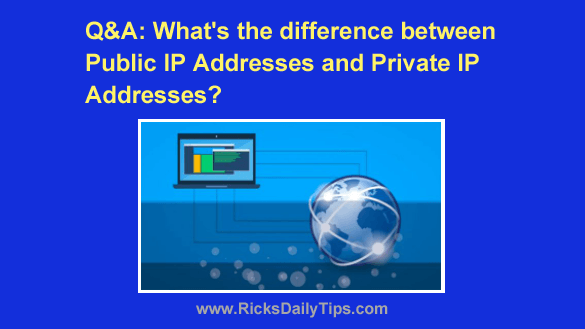 Question from Bill: I was reading the manual that came with my new IP camera and it referred to both public IP addresses and private IP addresses.
Question from Bill: I was reading the manual that came with my new IP camera and it referred to both public IP addresses and private IP addresses.
I got the camera working just fine but now I’m curious about the difference between public and private IP addresses.
Can you clear it up for me?
Rick’s answer: That’s a great question, Bill.
As you probably know, IP addresses are used to route data to the correct device on a network. When one device sends data to another device that data makes its way across the network to its destination device using its IP address.
Every device that’s connected to a network is identified by its own unique IP address just like every house is identified by its own physical address.
However, when we’re talking about Internet connectivity there are actually two different networks in play: the Internet at large and the private network in your home or office.
First, let’s discuss what we refer to as the Internet…
Although it’s much more complicated than this on a technical level, you can think of the Internet as everything that exists beyond your local router or gateway device.
That includes your Internet Service Provider (ISP) and all the numerous servers and other devices around the world that your local network can “talk” to.
Want to use Facebook or log in to your bank account to check your balance? You’ll need to access the Internet in order to do it.
Now, let’s discuss your own private network…
You now know the Internet consists of everything that’s connected to your home or office’s router through your ISP.
Your local network consists of basically everything that’s connected to the other side of your router.
Every computer or mobile device in your home or office that’s connected to your router by a cable or via WiFi can potentially talk to each other over the local network without using the Internet. In fact, you can disconnect your modem/gateway from the Internet completely and your local devices will still be able to “talk” to one another just fine.
For example, your devices can use a networked printer by talking directly to it over the local network.
And in your case, the IP camera you just installed works the same way (although you can probably access it via the Internet as well).
Here’s a simple diagram that shows the relationship between your local network and the Internet at large:

Pretty simple, right?
Now, let’s talk about IP addresses…
As you already know, every “connected” device you use has two types of IP addresses: Public and Private.
Your Public IP address is the address that another device on the Internet “sees” when it interacts with one of the devices on your local network.
Note: If you don’t know what your public IP address is you can find out instantly using this handy tool.
It doesn’t matter which device in your home or office that Internet-connected device is talking to, it will see the same Public IP address that it would see if it were talking to any other device in your home or office.
In a way, your local network’s Public IP address is like your home’s mailing address.
Every person living in your home gets their mail at the same “public” address (i.e. your mailing address).
When the mail carrier delivers the mail to your home or office they don’t even look at the individual names on the envelopes or packages. They just look at the street address and deliver it to that mailbox.
Once the mail is delivered to your mailbox, the person that checks the mail gives each each letter or package that arrives to the person it was actually sent to.
In this example you can think of the mailbox and the person that checks the mail as the “router”.
How does the person that checks the mail know who to give the individual items to? By looking for the recipient’s names on the packages!
The recipient’s name is sort of like that person’s Private IP address. Every person in the home has a unique name that identifies them to everyone else.
Likewise, every device that’s connected to your local network has its own Private IP address that identifies it to the router.
To summarize, when a device somewhere out there on the Internet sends data to your device it sends it to your local network’s Public IP address. Your local router/gateway then routes the info to your actual device via its Private IP address.
This is a simplified explanation of Public and Private IP addresses, but the vast majority of Internet users don’t really have a need to know all the technical details.
If you’re curious about what those details are this Google search will point you towards a number of in-depth resources.
I hope the above info cleared things up for you, Bill. Good luck!